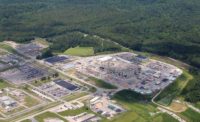Rail Advocates Have High Hopes for Future Funding
Private investors will be interested in high-speed-rail projects-if the federal funding stream remains consistent, experts say.

In particular, advocates are hoping the $2.5-billion Tampa-Orlando line will prove the mode’s viability. However, that project still lacks about $1.2 billion in funding.
The assurance of future federal funding is a key first step in attracting necessary private-sector investment, said Michael Cant, vice president of financial advisory services, SMI International Financial Advisory Group, Montreal. He led a session on private-sector financing this month at a conference in Orlando sponsored by the Washington, D.C.-based U.S. High-Speed Rail (USHSR) Association.
“There certainly is a lot of [investor] interest in U.S. high-speed rail,” Cant said. “There are a lot of expectations about the opportunity that will come for high-speed rail in the U.S. The time has just not arrived yet, though many of the right things are happening in Florida today.”
Cant noted that, based on studies of global rail projects, the way private-sector funding is arranged and managed is key to long-term success. “These major projects rarely fail for technical reasons,” Cant said. “Most of the time [they] fail due to the financial structures that are established.”
Nazih Haddad, chief operating officer of the Florida Dept. of Transportation’s Florida Rail Enterprise in Tallahassee, noted that while the Tampa-Orlando line is well along in preliminary engineering, Florida is going to require further funds to start construction.
“The Federal Railroad Administration is very cognizant of our project … and [of the importance of] making it a reality,” he said. Haddad argued that while other ARRA-funded rail projects around the country consist of improvements to existing systems that can be built in an incremental-type approach, that’s not the case in Florida.
“We are going to have to build the entire project, so we need the full funding for this project before we can move forward,” he said. An additional $2.5 billion for rail is included in the 2010 appropriations process, and Florida has its eyes on obtaining some of those additional funds.
Haddad says FDOT and FRA are working on establishing project milestones as well as discussing funding. FDOT is still debating whether to use design-build contracting or a more turnkey approach through a public-private partnership and a design-build-operate-maintain-finance contract.
The surety industry is eager to jump into the high-speed-rail market, said Drew Brach, managing director for Marsh USA’s Surety Practice. Sureties “want to bond these projects,” Brach said. “They’re very interested in pursuing this work. They want to provide the guarantees.”
The creation of an HSR investment fund, eventually totaling $100 billion, is at the top of USHSR’s agenda for 2010, says Andy Kunz, president and CEO.
“There’s a ton of money out there looking to invest in this,” Kunz said, noting that foreign investments could be substantial. “We’ve just started early discussions … and we’ve already generated enormous interest from a number of big players.”
The fund could be in place in time to affect the Florida project, Kunz added. “Florida could be a trial run, so to speak, and a test of the first piece of the fund.”
The USHSR will be working with engineering groups, operators and government agencies to create a national industry standard for construction and design. Signaling systems represent one area that needs standardization, Kunz said.
Here, too, the Florida project is having a national impact.
“We’re hoping to [finalize a standard] in the next couple of months, because we want to have it done before the Florida [project] is awarded,” Kunz said, adding that the U.S. High-Speed Rail Association would like to see this standard included in the requests for proposals that Florida and other states issue.
The original version of this story can be seen at www.ENR.com.





